By Dave McCracken General Manager

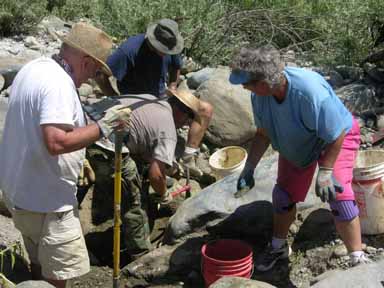

There were 23 participants on this surface mining Project, including myself. We decided to do it on the Club’s K-15A property. Our shore boss, Otto Gaither and several other New 49’er members had discovered high-grade gold on the gravel bar towards the upper-end of this very long mining property the season before. Since K-15A is such a long mining claim, we figured the small amount of earlier mining activity could barely have scratched the surface of the larger gold deposits which were sure to extend across the entire gravel bar.
The secret to our continuous success on these Projects is that we just follow through on an aggressive sampling program into areas where other New 49’er members have already discovered gold during the past.
Once again, Otto suggested that we set up our camp on one of the Club’s long-term camping areas on https://www.goldgold.com/k-15a-mega-hole.html K-15A. This is one of our favorite camping areas, because it has so much natural shade.
We devoted the first day (Saturday) on this Group Project to organizing our group camp, and to get all of our mining equipment set up along side of the river. With all the enthusiasm of this group, we still had time to start sampling on Saturday afternoon before we knocked off to attend the weekly potluck. Using gold pans to test with, it did not take long for this crew to establish that high-grade gold was present where we intended to start up the high-bankers on the following day.
My trusty assistants, Craig Colt, Mike O’Connell, Pat Harris and Leif Sollier were all present on this Project to lend a hand. Our shore boss, Otto, was also there to help organize all of our ongoing support needs, participate in the mining activity and help with everything else that needed doing. Since Otto was basically turning one of his own high-grade gold strikes over to this Project, we were depending upon him during the first few days to help us start building up some gold in our recovery bucket.
 We always try and start off these high-banking Projects using gold pans to do some preliminary sampling. This is mainly to make sure that all participants are competent with a pan in the beginning, because we will depend later in the week upon each person’s individual skills. It is also to help each participant identify what hard-packed streambed is, and what layer within the streambed that the pay-dirt is located. It is vital for each participant to be able to relate how much gold is being seen within a pan-sample to the amount of gold which can be recovered from the same location when a high-banker is being used. Here is a video sequence captured while I was talking about this very important subject on the second morning:
We always try and start off these high-banking Projects using gold pans to do some preliminary sampling. This is mainly to make sure that all participants are competent with a pan in the beginning, because we will depend later in the week upon each person’s individual skills. It is also to help each participant identify what hard-packed streambed is, and what layer within the streambed that the pay-dirt is located. It is vital for each participant to be able to relate how much gold is being seen within a pan-sample to the amount of gold which can be recovered from the same location when a high-banker is being used. Here is a video sequence captured while I was talking about this very important subject on the second morning:
Our plan was to start the week off mining the pay-streak that Otto had already located. Then, we would send sampling teams out across the (very) extensive area in search of perhaps an even richer gold deposit. It is always nice to start one of these Projects mining gold on the very first day. That gets things off in the right direction from the very beginning. Then, through some aggressive sampling, we are nearly always able to find one or more additional gold deposits nearby that are just as good or better than the one we started with. Finding a new gold deposit always adds a great feeling of success to the Project.
 We devoted the second and third days to dialing in some team production using three separate high-bankers. Through a little trial and error, we established that the high-grade gold was located within a contact zone between two different layers of streambed, only about eight inches beneath the surface. This made for some pretty easy digging! It didn’t take us long to work out a system of filling buckets with pay-dirt to be run through one of the high-bankers.
We devoted the second and third days to dialing in some team production using three separate high-bankers. Through a little trial and error, we established that the high-grade gold was located within a contact zone between two different layers of streambed, only about eight inches beneath the surface. This made for some pretty easy digging! It didn’t take us long to work out a system of filling buckets with pay-dirt to be run through one of the high-bankers.
Suction dredge attachments were connected to the other two high-bankers. Those were positioned so the water discharges could be directed across the top of the pay-dirt. This allowed us to set up two small dredging Projects well up on the gravel bar, increasing production so much that we had to slow down to keep from overloading the recovery systems. I found myself on the third day continuously telling the production crews to slow down, but they just thought I was kidding. Gold was really adding up in the recovery systems. Nothing was going to slow this crew down! Here follows a video segment that was captured as we were working the first area with the high-bankers:
The nice thing about using the dredge attachment on a high-banker well up on a gravel bar in California is that the activity does not normally require a dredging permit. But you must make certain there is no discharge of dirty water or other material off the stream bank into the active waterway. Fortunately, natural contours on the upper gravel bar at K-15A provide a huge settling area where this can be accomplished. We worked out a rotation so that everyone was able to spend some time working the suction nozzles on these high-bankers.


We do not do full clean-ups on our recovery systems every day on these Projects, because the full process requires too much time. Rather, we dump-off the high-grade portions of the recovery systems at the end of each day so we can get a pretty close idea how we were doing. The gold and other heavy material from each day get placed in a single bucket which remains in my personal care until the end of the week. Here follows a video sequence which was captured as we cleaned the high-grade sections of our recovery systems at the end of our third day:
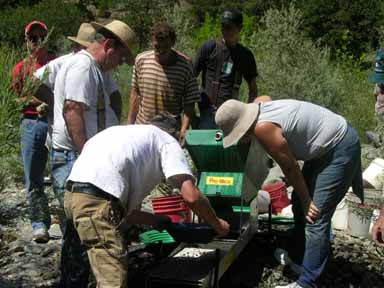 Earlier in the week, we had pulled two of the Club’s rafts out of storage in anticipation of maybe using them to do some sampling in some of the more-remote high-banking areas located on K-17. I know of one place in particular down there where we could likely get into a pretty good deposit of nice gold nuggets. Earlier in the week, everyone was pretty excited about the prospect of a nugget deposit (and an exciting day rafting down the river). But on the morning of the forth day, Otto informed me that this group had already voted unanimously to save K-17 for a later Project. They decided we were finding too much gold to leave the place we had started and go on a rafting trip somewhere else!
Earlier in the week, we had pulled two of the Club’s rafts out of storage in anticipation of maybe using them to do some sampling in some of the more-remote high-banking areas located on K-17. I know of one place in particular down there where we could likely get into a pretty good deposit of nice gold nuggets. Earlier in the week, everyone was pretty excited about the prospect of a nugget deposit (and an exciting day rafting down the river). But on the morning of the forth day, Otto informed me that this group had already voted unanimously to save K-17 for a later Project. They decided we were finding too much gold to leave the place we had started and go on a rafting trip somewhere else!
With that in mind, on the forth morning, Craig and Leif both led separate prospecting teams out across the huge bar on K-15A. They were in search of new and better high-grade gold deposits. While Leif’s team was starting to turn up some positive signs in one area, at about mid-day, someone from Craig’s team came down and told me that Craig had located a rich virgin gold deposit up towards the very top-end of the bar. Off I went to see what he had turned up. It was quite a ways up there; this is a very large high-banking area which is sure to keep a lot of people happy for many years to come!
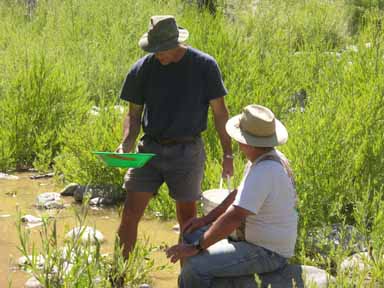

Sure enough, Craig was turning up some nice gold out of a top flood layer that was about twelve inches deep. Then he was getting even more gold inside of an orange-colored hard-pack that was sitting down on top of yet another layer of ancient gray material. The orange
material was also about twelve inches thick. By the time I arrived, Craig had already identified around two feet of streambed material which was paying quite well. This was a very exciting development! Here follows a video sequence capturing Craig just as he made the discovery:
Since we were already getting so much gold using the dredge attachments on the high-bankers further downstream, we decided the smart thing to do was to just move the third high-banker to Craig’s discovery as the first step. But after running the first production sample up there, we realized that we could get more gold in the new location. Shortly thereafter, our entire crew was busy moving all of our gear to the top of the bar. Since we were finished in Otto’s initial discovery (until we go back there some day), we carefully filled in the excavations so no open holes would be left behind.


There is a turning point in every one of these Projects when some new development changes the group chemistry into something new and different. This usually happens when sampling turns up a new, richer gold deposit. The new discovery often triggers a sudden cumulative motivation to recover as much of the gold that we can get in the time remaining in the Project. Everyone gets into the spirit of this. I patiently wait for this transition on every Project, sometimes worrying that it will not happen.
On one of the dredging Projects last season, since the river was still too high and fast to allow us to sample out in the middle of the river, our sampling team was experiencing frustration all the way through the fifth day, because I kept pulling them out of the lower-grade gold deposits they were finding, in hopes of finding something better. We finally touched down on high-grade on the morning of the sixth day. We then had all the participants go down and experience what it feels like to see bedrock cracks which are laced with rich, beautiful gold and nuggets as we uncovered a treasure of Mother Nature’s natural wealth. Then, everybody understood what we had been holding out for all week long. As a very determined team, they pulled themselves together and recovered more gold in several hours than we had already accumulated in five days of hard work! Once that kind of motivation kicks in, I usually just step back and let it go.


The fifth and sixth days on this high-banking Project found our entire crew working together to keep two hungry high-bankers well fed with good pay-dirt that was being excavated from three separate holes. We were digging deeper in this new location, so we decided against using the dredge attachments. Dredging would have filled the deeper holes with water, preventing us from being able to effectively deal with the bigger boulders in this place. Indeed, Craig had located an old original (never been touched by earlier mining activity) streambed which was packed-up with medium-sized granite boulders. In order to open up the excavations so that we had some working room, we set up a portable grip-puller, hand-operated winch so that we could pull several of the boulders out. With some teamwork, this did not take very long. As usual, Leif (nick-named “Hercules”) insisted upon doing most of the heavy work. Here follows a video segment that was captured as we were working the newly-found pay-streak. Check out the size of those boulders!

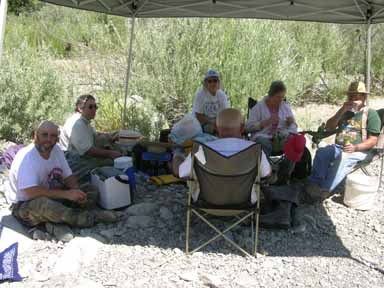
Mainly, the fifth and sixth days of this Project involved non-stop filling, packing and pouring of buckets-full of pay-dirt into the high-bankers. It was hot out there in the sun, so one of the participants treated us to the use of his shade canopy where we could eat lunch or take a break. We only shut down the high-bankers once during the day to fuel the motors and do a quick clean-up of the high-grade portions of the high-bankers to get an idea how much gold we were recovering. We were doing pretty well! And we were also getting some nice gold nuggets! Everyone was pushing as hard as we could to break a production record in gold recovery. The previous high-banking record was 64 pennyweights (3.2 ounces). Going into the sixth day of this Project, there was no doubt in my mind that this was the hardest-working high-banking team I had ever been with!
 The high-banker clean-ups on the fifth day were as good as we had done all week. But we spent too much time digging in the ancient gray layer which was under the orange material. That stuff was hard and slow to dig! But it sure looked rich! Because we were spending so much time in it, we decided to have several participants do some very careful pan-sampling of the gray to see how much gold was being recovered from it. This took some doing, because it required extra care to remove every bit of the orange layer (which contained a lot of gold) off the top of the gray, without allowing any gold from above to drop down into the gray and give us a false result.
The high-banker clean-ups on the fifth day were as good as we had done all week. But we spent too much time digging in the ancient gray layer which was under the orange material. That stuff was hard and slow to dig! But it sure looked rich! Because we were spending so much time in it, we decided to have several participants do some very careful pan-sampling of the gray to see how much gold was being recovered from it. This took some doing, because it required extra care to remove every bit of the orange layer (which contained a lot of gold) off the top of the gray, without allowing any gold from above to drop down into the gray and give us a false result.
By the end of the fifth day, we had determined that we would recover more gold if we just processed the layers which were above the gray. So we focused all of our energy into that on the sixth day. This paid off with the best clean-up for the week on Thursday afternoon. We were all hopeful of breaking the Club’s previous record. There were a lot of really good feelings going around as we performed the final clean-up on Thursday afternoon. Here follows some video which was captured as we finished our last day out on the river:
 I have come to know the spirit of team camaraderie that a tight group of people experience together when we have done something extraordinary together. It is a great feeling which is always just a bit different from one group to the next. Being part of these groups is a humbling experience for me, and I always feel a little sadness with the realization that a group Project is nearly over. Here is what several participants were feeling as we were finishing up the week:
I have come to know the spirit of team camaraderie that a tight group of people experience together when we have done something extraordinary together. It is a great feeling which is always just a bit different from one group to the next. Being part of these groups is a humbling experience for me, and I always feel a little sadness with the realization that a group Project is nearly over. Here is what several participants were feeling as we were finishing up the week:
Each participant is invited to participate in the final clean-up steps. This is because there is a lot of work involved with separating all of the gold from all of the black (iron) sands. This usually all takes place on Friday afternoon after we have removed the Club’s mining equipment from the river. Since we were not far from Club headquarters, we decided to do the final clean-up in the back shipping area where we could be out of the sun and in a more controlled environment. The team pulled all the supplies together for a barbeque that would follow the week’s gold split.


 Final gold clean-up and split-off is always one of the best parts of these Projects. It is a time when we can all relax a bit, knowing that we worked as hard as we were able, and everyone has an opportunity to google a bit over all the gold that we recovered together. It is a time for some light joking around and expression of friendship and shared group camaraderie; a magic feeling that is timeless at the moment you experience it.
Final gold clean-up and split-off is always one of the best parts of these Projects. It is a time when we can all relax a bit, knowing that we worked as hard as we were able, and everyone has an opportunity to google a bit over all the gold that we recovered together. It is a time for some light joking around and expression of friendship and shared group camaraderie; a magic feeling that is timeless at the moment you experience it.
The following video sequence captured the steps that we usually follow during a final clean-up. Background sounds in the video tell the story about how we all felt perhaps even better than the visuals! Witness the expectation and exultation that we all felt when we all realized that we actually did break the Club’s high-banking record!







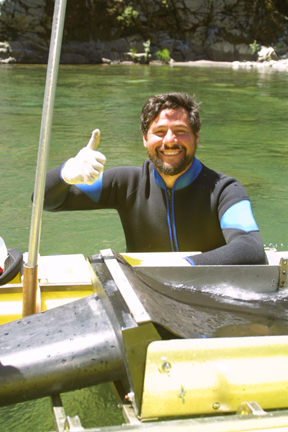
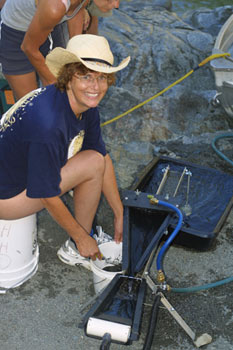






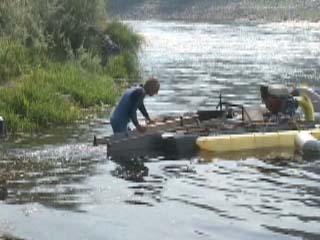 After he bought his own 6-inch dredge, Lee recovered over 66 ounces of gold on a single day. That day’s take included 1.5-pound and 2-pound nuggets. It was his best day ever. He worked everyday for 6 weeks, cleaning his recovery system several times a day. He was recovering large amounts of gold on every
After he bought his own 6-inch dredge, Lee recovered over 66 ounces of gold on a single day. That day’s take included 1.5-pound and 2-pound nuggets. It was his best day ever. He worked everyday for 6 weeks, cleaning his recovery system several times a day. He was recovering large amounts of gold on every 
 Gary Price is one of Lee’s happiest students. He says Lee taught him how to find gold along the Klamath River.
Gary Price is one of Lee’s happiest students. He says Lee taught him how to find gold along the Klamath River.
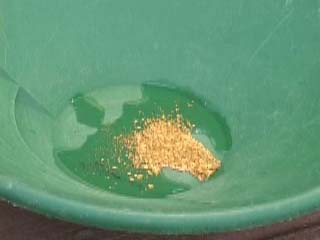

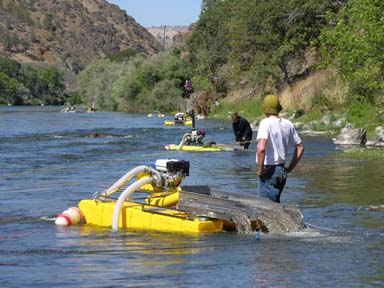
 Three of the participants were
Three of the participants were 



 By the end of the third day, our remaining three people on the beginner-team were managing the second 4-inch dredge all by themselves, and had launched into
By the end of the third day, our remaining three people on the beginner-team were managing the second 4-inch dredge all by themselves, and had launched into 
 Meanwhile, Ken’s team on the other side of the river decided to dredge a hole down through the hard-pack to see if they could find bottom. They found it at a depth of around four feet in the gray-pack. With even more luck on our side, through some trial and error, they discovered that in addition to the surface gold deposit, the gray layer of hard-pack was also paying consistently in fine gold and flakes throughout the material. Then they found the largest nugget of the week on the fourth day. So they devoted the remainder of the week production-dredging to the bottom.
Meanwhile, Ken’s team on the other side of the river decided to dredge a hole down through the hard-pack to see if they could find bottom. They found it at a depth of around four feet in the gray-pack. With even more luck on our side, through some trial and error, they discovered that in addition to the surface gold deposit, the gray layer of hard-pack was also paying consistently in fine gold and flakes throughout the material. Then they found the largest nugget of the week on the fourth day. So they devoted the remainder of the week production-dredging to the bottom. Also, it appears to me that we are attracting more experienced miners to the Projects. This increased experience helps focus the Projects in a more productive direction.
Also, it appears to me that we are attracting more experienced miners to the Projects. This increased experience helps focus the Projects in a more productive direction.
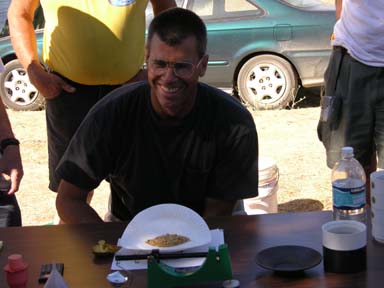


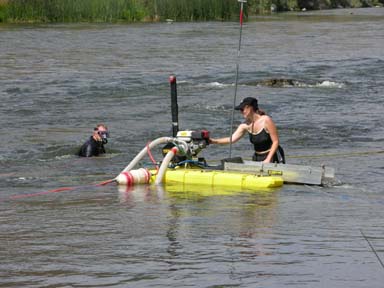


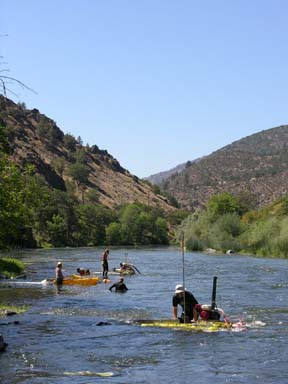



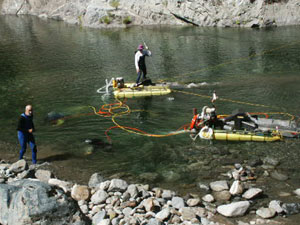
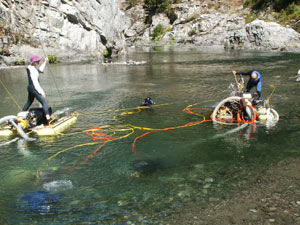
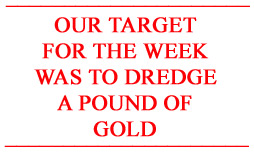

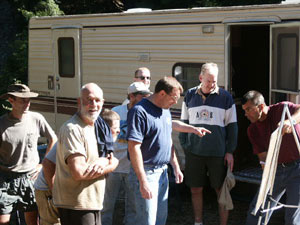





 Herb Miller and Doti Buruursema prepare to start a sample hole on the far side of the river.
Herb Miller and Doti Buruursema prepare to start a sample hole on the far side of the river. Sandy Crawford always ready to light up the day with a big smile.
Sandy Crawford always ready to light up the day with a big smile.


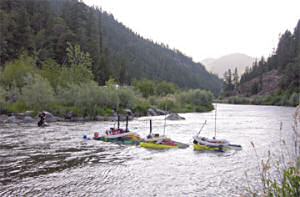
 We never use mercury or any chemicals in the process. It is important for every prospector to know how to do the final gold separation. On our projects, under my careful guidance, the participants do almost all of the work. But I always get the personal pleasure of weighing out all the final shares.
We never use mercury or any chemicals in the process. It is important for every prospector to know how to do the final gold separation. On our projects, under my careful guidance, the participants do almost all of the work. But I always get the personal pleasure of weighing out all the final shares.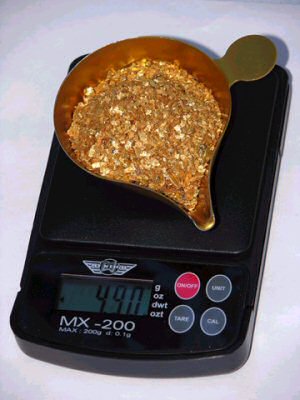






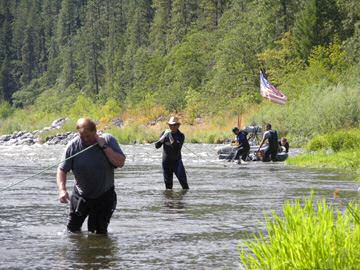

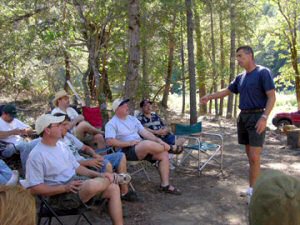





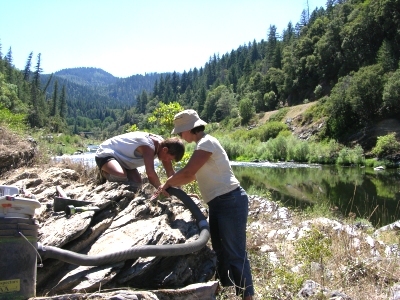
 Dennis Taylor, Craig Colt & Dick Bendtzen
Dennis Taylor, Craig Colt & Dick Bendtzen

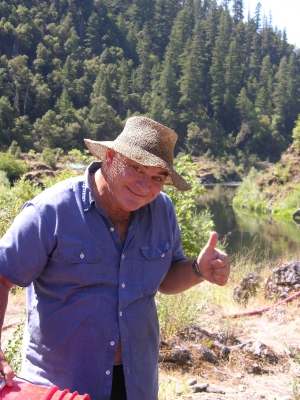 On the morning of day-6, Dick told me he was getting a very strong feeling about an area just downstream from where Rex & Earlene had made their big strike. So he decided to hike up there and do a few samples. It was quite a ways up there; but about an hour later, I thought I could see Dick waving his arms around. So I drove the boat over there to have a look. Sure enough, Dick had made the richest strike of the week! It was under about 2 feet of hard-packed streambed on bedrock. The whole area had been buried under about 6 inches of loose sand. That was the reason we missed it the first time we were sampling around there. Dick’s samples were producing large flakes and small nuggets. It was truly a rich find! This is
On the morning of day-6, Dick told me he was getting a very strong feeling about an area just downstream from where Rex & Earlene had made their big strike. So he decided to hike up there and do a few samples. It was quite a ways up there; but about an hour later, I thought I could see Dick waving his arms around. So I drove the boat over there to have a look. Sure enough, Dick had made the richest strike of the week! It was under about 2 feet of hard-packed streambed on bedrock. The whole area had been buried under about 6 inches of loose sand. That was the reason we missed it the first time we were sampling around there. Dick’s samples were producing large flakes and small nuggets. It was truly a rich find! This is  By the end of the 6th day, we had a good showing of larger-sized gold to go along with all the fines we had accumulated earlier in the week.
By the end of the 6th day, we had a good showing of larger-sized gold to go along with all the fines we had accumulated earlier in the week.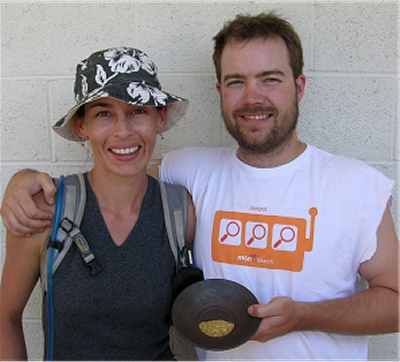 At the end of the 7th day, we split off the shares of the gold evenly between all the participants. Everyone was excited to get their share. We then took a moment to review our week and discuss the things that we did, and the decisions that we made along the way, which led us into our good fortune. Sampling is an interesting process whereby
At the end of the 7th day, we split off the shares of the gold evenly between all the participants. Everyone was excited to get their share. We then took a moment to review our week and discuss the things that we did, and the decisions that we made along the way, which led us into our good fortune. Sampling is an interesting process whereby 
 California Gold Rush.” The other two journalists, Justin and John, were from New York. They were representing Fortune Small Business Magazine, speaking with those in attendance regarding their feelings on gold prospecting, why they were here, and what they enjoyed about the whole
California Gold Rush.” The other two journalists, Justin and John, were from New York. They were representing Fortune Small Business Magazine, speaking with those in attendance regarding their feelings on gold prospecting, why they were here, and what they enjoyed about the whole  Armed with all the useful information and necessary gear, we all headed off after lunch to
Armed with all the useful information and necessary gear, we all headed off after lunch to 


 During a short lunch break, everyone had their first glimpse of what all their hard work was for. You could almost touch the excitement when Dave swished around a sample from the high-bankers in a gold pan for all to see. Anyone who has ever experienced that moment knows exactly what I am talking about; gold fever! We were getting a lot of
During a short lunch break, everyone had their first glimpse of what all their hard work was for. You could almost touch the excitement when Dave swished around a sample from the high-bankers in a gold pan for all to see. Anyone who has ever experienced that moment knows exactly what I am talking about; gold fever! We were getting a lot of 

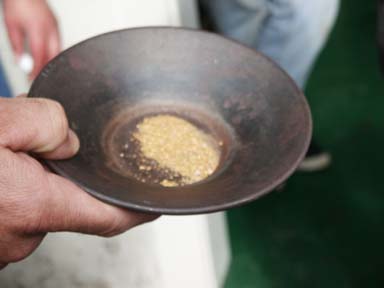








 Jake’s 5-inch dredge remained in the same place all week long. This was because the dredge was recovering a handsome showing of fine gold alongside the highway-side of the river. Several beginners graduated up to Matt’s dredge that was working the very same fine-gold deposit further upstream, only in deeper water. The remainder of the beginner-team utilized the rest of the week to develop a production dredging program so they could recover as much gold as possible.
Jake’s 5-inch dredge remained in the same place all week long. This was because the dredge was recovering a handsome showing of fine gold alongside the highway-side of the river. Several beginners graduated up to Matt’s dredge that was working the very same fine-gold deposit further upstream, only in deeper water. The remainder of the beginner-team utilized the rest of the week to develop a production dredging program so they could recover as much gold as possible. As Matt and Jennifer had already located some kind of pay-streak further upriver the week before, we decided that would be a great place for them to operate the 5-inch dredge during the first day or two of this Project. But when we towed the 5-inch dredge up there using the boat, we discovered that someone else had already moved in on the location. This turned out to be an old grizzly-looking gold miner who materialized there from 150 years ago. When we pulled up in the boat, he gave us a very friendly welcome and showed us all the gold that he was recovering from just digging gravel from the bottom of the river (using a shovel!) in about 5 feet of water. He had
As Matt and Jennifer had already located some kind of pay-streak further upriver the week before, we decided that would be a great place for them to operate the 5-inch dredge during the first day or two of this Project. But when we towed the 5-inch dredge up there using the boat, we discovered that someone else had already moved in on the location. This turned out to be an old grizzly-looking gold miner who materialized there from 150 years ago. When we pulled up in the boat, he gave us a very friendly welcome and showed us all the gold that he was recovering from just digging gravel from the bottom of the river (using a shovel!) in about 5 feet of water. He had  As we had already targeted that same area for some dredge sampling, but the other guy was in there ahead of us, we were initially concerned about not stepping on his right to mine the immediate location. But he told us that he didn’t mind, because he did not have the equipment to get further out into the river where we wanted to go. There was plenty of room for everyone. Otto captured the following video sequence showing us working side-by-side. It’s only one of the few times I have ever watched a prospector recovering an impressive amount of gold from underwater with the use of a normal hand-shovel!
As we had already targeted that same area for some dredge sampling, but the other guy was in there ahead of us, we were initially concerned about not stepping on his right to mine the immediate location. But he told us that he didn’t mind, because he did not have the equipment to get further out into the river where we wanted to go. There was plenty of room for everyone. Otto captured the following video sequence showing us working side-by-side. It’s only one of the few times I have ever watched a prospector recovering an impressive amount of gold from underwater with the use of a normal hand-shovel! Matt’s team opened up a test hole not far upstream from where the member was shoveling gold off the bottom of the river; and it only took a few hours before Matt was showing us some incredible initial sample results. Here follows a video sequence that was captured just as Matt and Jennifer were showing off the first good sample result from their dredge:
Matt’s team opened up a test hole not far upstream from where the member was shoveling gold off the bottom of the river; and it only took a few hours before Matt was showing us some incredible initial sample results. Here follows a video sequence that was captured just as Matt and Jennifer were showing off the first good sample result from their dredge: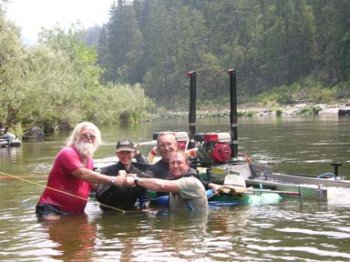
 So it was with this in mind that we started Richard’s team early in the week, sampling the far side of the river. The problem was that they were finding a lot of sand over there. The thing about sand is that you never know how deep it’s going to go without at least trying to dredge a hole down through it. So you can eat up days and days just trying to reach down to find bottom!
So it was with this in mind that we started Richard’s team early in the week, sampling the far side of the river. The problem was that they were finding a lot of sand over there. The thing about sand is that you never know how deep it’s going to go without at least trying to dredge a hole down through it. So you can eat up days and days just trying to reach down to find bottom!
 Without the fast current to slow us down, we were able to get a
Without the fast current to slow us down, we were able to get a 
 Pretty soon, we were spending more time dredging, than planning – and the gold nuggets started adding up. Here follow 2 video sequences that were captured as we were cleaning up some beautiful gold nuggets from several different dives:
Pretty soon, we were spending more time dredging, than planning – and the gold nuggets started adding up. Here follow 2 video sequences that were captured as we were cleaning up some beautiful gold nuggets from several different dives:




